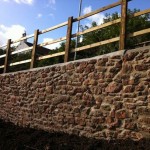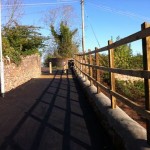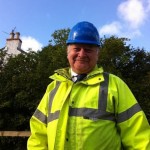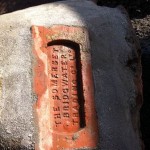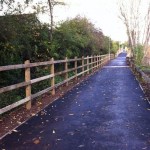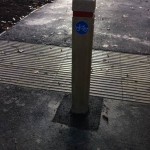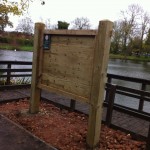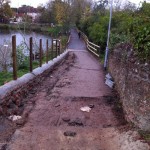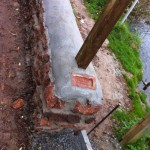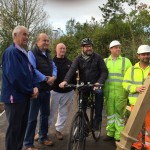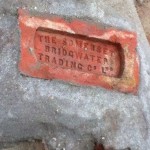
Back in June 2013 when The Bridgwater Way (TBW) had set up camp in Rhode Lane, local people were consulted about the problem areas in Hamp in respect of the streets and urban environment. One of the areas that was highlighted as desperate for improvement was the path that runs adjacent to Browne’s Pond. This path was identified as a major route for pedestrians, cyclists and mobility scooterists to get from Hamp to Morrisons, the YMCA, and via Broadway to the town centre.
Users of the path were reporting issues ranging from cyclists whizzing at speed and pushing or skirting dangerously close to pedestrians, of children tripping into the rhyne (and some jumping across in a form of extreme sport) and mobility scooters toppling over when descending from the bridge. All in all, the shared use of the path by these multiple user groups, was proving problematic and often dangerous. The increasing population of Hamp meant that the squash of bodies navigating the narrow path was going to worsen. TBW was encouraging people to walk and cycle more and use their cars less, so it made good sense to address the problem of pedestrian and cyclist congestion sooner rather than later.
Working to improve the area

A group of local volunteers, Friends of Browne’s Pond (FOBP), had been working hard to improve this area. Having experienced success in cleaning, revitalising and uplifting the pond and environs, they were keen to see the path widened and made safer for local people.
TBW picked up on the concerns raised by FOBP and other local residents regarding the path and in August 2013 Richard Needs (Somerset County Council – Highways) presented design options for consideration. FOBP and residents selected the design that they felt to be most sympathetic, achievable and aligned with National Guidelines in terms of public safety.
That initial design meeting at Hamp Re-Creation, was followed by more meetings and working together the FOBP, local residents, Cllr. Brian Smedley, TBW and Richard Needs brought the pathway project to a point where it was shortly to be implemented. Then it all came to a full stop as the project took a back seat to other TBW projects that had overrun.
Best possible result
Months passed with no action and not wishing the path to drop off the Council’s list of works, the FOBP and residents group decided to ask County Councillor Leigh Redman to help get the project back on track. Leigh got on board and engaged with Somerset County Council to drive the project forward to implementation.

All parties involved in the improvement of the path have worked to achieve the best possible result, under tight budgetary and time constraints. Inevitably, compromises have had to be made, however, the end results are a testament to what can be achieved if the community, council and councillors all direct their energies to achieving a common goal.
The end result is a huge upgrade to this path. It has been widened to comfortably accommodate all the different types of users. Intersections of paved areas break up the tarmac and provide speed breaks. Safety features include a high wooden fence on the rhyne-side and a low fence on the pond-side. FOBP have constructed a new, large noticeboard which has been erected behind the duck-feeding platform. A section of the bridge wall was removed and a beautiful new lowered wall has been built by local resident and builder Neil Smallwood re-using the original stones and insetting an original Bridgwater brick (that was made by John Browne’s company after whom Browne’s Pond is named). The view looking over the bridge and onto the Browne’s Pond area is stunning and the whole area has been enhanced by this pathway improvement.
Report by Simi Bignall (Resident)

